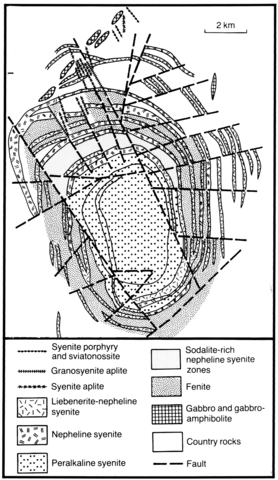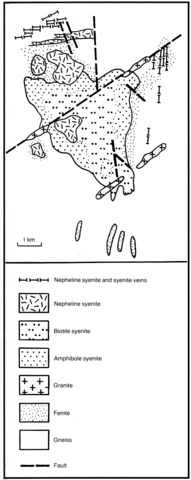stripes
Borsuksai is situated amongst Precambrian gneisses and metamorphosed shales in the eastern part of the Mugodzharsky mega-anticlinorium, where it coincides with the intersection of north-south- and east-west-trending faults. Two rather different geological accounts and maps of Borsuksai are available, one by Nurlibayev (1973) (Fig. 65) and one by Semenov et al. (1974) (Fig. 66). According to Nurlibayev (1973) the intrusion extends over about 50 km2 and is emplaced in Precambrian biotite and granite gneisses and mid-Palaeozoic diorites, gabbros and gabbro-amphibolites. He distinguishes five intrusive stages the first of which is represented by dykes and sheets of hastingsite-biotite syenite and liebenerite syenite, which were followed by nepheline-, aegirine-, biotite-, sodalite- and amphibole-bearing syenites. The third phase comprises muscovite and nepheline-microcline pegmatites and syenitic aplites, which were followed by injection of veins of syenite porphyry. During the fifth stage alaskitic granite, granite aplite and granite pegmatite were intruded. The country rocks immediately adjacent to the complex are fenitized and zones rich in sodalite and quartz-feldspar metasomites were developed while quartz and calcite veins containing fluorite and sulphides were injected. Semenov et al. (1974) present a simpler picture of an intrusion with a core of biotite syenite and a periphery of hastingsite syenites, which rocks are cut by small intrusions and veins of nepheline syenite. Dykes of nepheline syenite from 0.1 to 30 m thick are described as extending for up to 10 km from the complex and are accompanied by dykes of peralkaline syenite, granosyenite, syenite porphyry, syenite aplite, bostonite and sviatonossite (andradite-bearing syenites). Pegmatitic areas, up to several metres long, occur in the central parts of some nepheline syenite dykes. The enclosing shales and gneisses near the contact of the central complex are fenitized and xenoliths of the country rocks are present in the central parts of the massif. The nepheline syenites are fine-grained, often trachytic rocks which contain about 20-40% of nepheline, 5-20% of coloured minerals (biotite, hastingsite and aegirine), microcline and albite; biotite-hastingsite-bearing varieties are the most widespread. Secondary and accessory minerals found in these rocks include fluorite, cancrinite, sodalite, calcite, natrolite, pyrochlore, zircon, orthite, monazite, bastnaesite, britholite, ancylite, thorite and sulphides. Peralkaline syenites contain microcline, oligoclase, biotite, aegirine, riebeckite and hastingsite. Accessories include zircon, rutile, columbite, titanite, apatite, garnet and Fe-Ti oxides with secondary albite, muscovite, natrolite and calcite. Miaskitic nepheline syenite pegmatites form sets of concordant veins 2-50 m thick and hundreds of metres long in the country rocks. Generally they are unzoned but infrequently they have two zones the central one of which displays large block structures. Albitites are widely distributed and form zones hundreds of metres long and up to 2 m thick in the marginal part of vein bodies, and less frequently in rocks of the massif itself. The albitites are enriched in rare-metal minerals including columbite, zircon, rutile and thorite. Interesting discoveries of concentrically zoned aggregates of rare-earth minerals have been made and these include monazite-britholite-orthite, britholite (including the variety lessingite)-orthite and bastnaesite-britholite-orthite.
BORODIN, L.S. 1974. The main provinces and formations of the alkaline rocks. Nauka, Moscow. 376 pp.
Levin, 1974; Levin et al., 1973;
NURLIBAYEV, A.N. 1973. Alkaline rocks of Kazakhstan and their ore deposits. Nauka, Alma-Ata. 296 pp.
Semenov et al., 1974.


